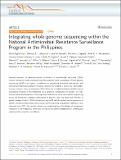Integrating whole-genome sequencing within the National Antimicrobial Resistance Surveillance Program in the Philippines
Abstract
National networks of laboratory-based surveillance of antimicrobial resistance (AMR) monitor resistance trends and disseminate these data to AMR stakeholders. Whole-genome sequencing (WGS) can support surveillance by pinpointing resistance mechanisms and uncovering transmission patterns. However, genomic surveillance is rare in low- and middle-income countries. Here, we implement WGS within the established Antimicrobial Resistance Surveillance Program of the Philippines via a binational collaboration. In parallel, we characterize bacterial populations of key bug-drug combinations via a retrospective sequencing survey. By linking the resistance phenotypes to genomic data, we reveal the interplay of genetic lineages (strains), AMR mechanisms, and AMR vehicles underlying the expansion of specific resistance phenotypes that coincide with the growing carbapenem resistance rates observed since 2010. Our results enhance our understanding of the drivers of carbapenem resistance in the Philippines, while also serving as the genetic background to contextualize ongoing local prospective surveillance.
Citation
Argimón , S , Masim , M A L , Gayeta , J M , Lagrada , M L , Macaranas , P K V , Cohen , V , Limas , M T , Espiritu , H O , Palarca , J C , Chilam , J , Jamoralin , M C , Villamin , A S , Borlasa , J B , Olorosa , A M , Hernandez , L F T , Boehme , K D , Jeffrey , B , Abudahab , K , Hufano , C M , Sia , S B , Stelling , J , Holden , M T G , Aanensen , D M & Carlos , C C 2020 , ' Integrating whole-genome sequencing within the National Antimicrobial Resistance Surveillance Program in the Philippines ' , Nature Communications , vol. 11 , 2719 . https://doi.org/10.1038/s41467-020-16322-5
Publication
Nature Communications
Status
Peer reviewed
ISSN
2041-1723Type
Journal article
Description
Funding: This work was funded by the Newton Fund, Medical Research Council (UK) grant MR/N019296/1, Philippine Council for Health Research and Development project number FP160007. J.S. was partially supported by research grants RR025040 and U01CA207167 from the National Institutes of Health (NIH). S.A. and D.M.A. were additionally supported by the National Institute for Health Research (UK) Global Health Research Unit on genomic Surveillance of AMR(16_136_111) and by the Centre for Genomic Pathogen Surveillance (http://pathogensurveillance.net).Collections
Items in the St Andrews Research Repository are protected by copyright, with all rights reserved, unless otherwise indicated.

